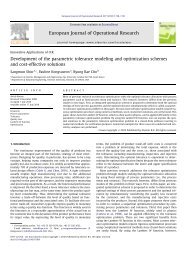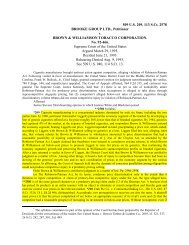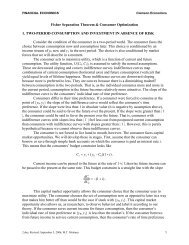A comparative discrete-dislocation/nonlocal crystal-plasticity
A comparative discrete-dislocation/nonlocal crystal-plasticity
A comparative discrete-dislocation/nonlocal crystal-plasticity
You also want an ePaper? Increase the reach of your titles
YUMPU automatically turns print PDFs into web optimized ePapers that Google loves.
typeset2:/sco3/jobs1/ELSEVIER/msa/week.17/Pmsa15088y.001 Wed May 16 07:53:37 2001 Page Wed<br />
D. Columbus, M. Grujicic / Materials Science and Engineering A000 (2001) 000–000 17<br />
<strong>crystal</strong> lattice, C 1 , is generally an open contour, and<br />
hence, the line integral C 1dY defines the closure failure.<br />
Since the total Burgers vector B completes the circuit<br />
C 1 , it can be defined as:<br />
B=− dY=− FpdX (A2)<br />
C 1<br />
C<br />
Eq. (A2) can be transformed into:<br />
B=− (×F pT ) Tr0 dS= r0 dS (A3)<br />
S<br />
using a generalized Stokes theorem. in Eq. (A2) is the<br />
so-called Nye’s tensor [26], and is defined as the tensorial<br />
curl of F p as:<br />
−(×F pT ) T (A4)<br />
The material derivative of the Nye’s tensor can be<br />
defined as:<br />
−(×F pT ) T (A5)<br />
which through the use of Eq. (19), becomes:<br />
=−[×(LpFp ) T ] T =−× <br />
m pnTT<br />
0n0 F<br />
(A6)<br />
Next, the portion of associated with activity of slip<br />
system is defined as:<br />
−{×[( m 0 n0 )F p ] T } T<br />
S<br />
=−m 0 [×( F pT n0 )] (A7)<br />
Thus<br />
= <br />
<br />
(A8)<br />
Next, a phenomenological equation for is defined as<br />
follows. is assumed to scale with the accumulation<br />
rate of three sets of geometrically necessary <strong>dislocation</strong>s<br />
all with Burgers vectors in the m0 direction: (a) a set of<br />
screw <strong>dislocation</strong>s with tangent vector in the m0-direc tion; (b) a set of edge <strong>dislocation</strong>s with tangent vector<br />
in the x3-direction; and (c) a set of edge <strong>dislocation</strong>s<br />
with tangent vector in the n0-direction. Hence, for a<br />
cubic lattice with a common Burgers vector magnitude,<br />
b, can be written as:<br />
=m0b( G m0+ G p0+ G n0) (A9)<br />
(s )<br />
(e )1<br />
(e )2<br />
where G , G , and G are the accumulation<br />
(s ) (e )1<br />
(e )2<br />
rates of density of the three aforementioned sets of<br />
geometrically necessary <strong>dislocation</strong>s, respectively. A<br />
comparison of the second Eq. (A7) and Eq. (A9) yields:<br />
UNCORRECTED PROOF<br />
−×( F pT n 0 )=b( G (s)m 0 + G (e)1p 0 + G (e)2n 0 ) (A10)<br />
It can be easily shown that for in-plane-strain deformation,<br />
(F P 13=F P 23=F P 31=F P 32=0, F P 33=1), Eq. (A10)<br />
yields:<br />
G (s)=0, G (e)2=0<br />
and<br />
G (e )1<br />
= 1<br />
d<br />
[ P P (F 11n<br />
0(1) +F21n<br />
0(2) )]<br />
bp 0(3) dx2 − d<br />
[<br />
dx1 P P (F 12n<br />
0(1) +F22n<br />
0(2) )] (A11)<br />
Eq. (A11) is an evolution equation for the density of<br />
geometrically necessary <strong>dislocation</strong>s and is used in Section<br />
2.2 to evaluate the non-local contribution to the<br />
slip resistance.<br />
References<br />
[1] G.R. Irwin, Fracture, in: S. Flugge (Ed.), Encyclopedia of<br />
Physics, vol. 6, Springer New York, New York, 1958, pp.<br />
551–590.<br />
[2] L.B. Freund, The mechanics of <strong>dislocation</strong>s in strained-layer<br />
semiconductor-materials, Adv. Appl. Mech. 30 (1994) 1–66.<br />
[3] V. Tvergaard, J.W. Hutchinson, The relation between crack<br />
growth resistance and fracture process parameters in elastic-plastic<br />
solids, J. Mech. Phys. Solids 40 (1992) 1377–1397.<br />
[4] I.-H. Lin, R. Thomson, Cleavage, <strong>dislocation</strong> emission, and<br />
shielding for cracks under general loading, Acta Metall. 34<br />
(1986) 187–206.<br />
[5] V. Shastry, P.M. Anderson, R. Thomson, Nonlocal effects of<br />
existing <strong>dislocation</strong>s on crack-tip emission and cleavage, J.<br />
Mater. Res. 9 (1994) 1–16.<br />
[6] A. Needleman, A continuum model for void nucleation by<br />
inclusion debonding, J. Appl. Mech. 54 (1987) 525–531.<br />
[7] N.A. Fleck, J.W. Hutchinson, Strain gradient <strong>plasticity</strong>, Adv.<br />
Appl. Mech. 33 (1997) 295–361.<br />
[8] N.A. Fleck, G.M. Muller, M.F. Ashby, J.W. Hutchinson, Strain<br />
gradient <strong>plasticity</strong>: theory and experiment, Acta Metall. Mater.<br />
42 (1994) 475–487.<br />
[9] A. Acharya, J.L. Bassani, Incompatibility and <strong>crystal</strong> <strong>plasticity</strong>,<br />
J. Mech. Phys. Solids (1998) (in press).<br />
[10] H. Dao, Parks, Geometrically necessary <strong>dislocation</strong> density in<br />
continuum <strong>plasticity</strong> theory, FEM implementation and application,<br />
PhD Thesis, MIT, August 1997.<br />
[11] Z. Suo, C.F. Shih, A.G. Varias, A theory for cleavage cracking<br />
in the presence of plastic flow, Acta Metall. Mater. 41 (1993)<br />
1551–1557.<br />
[12] H.H. M. Cleveringa, E. van der Giessen, A. Needleman, A<br />
<strong>discrete</strong> <strong>dislocation</strong> analysis of mode I crack growth, J. Mech.<br />
Phys. Solids (in press)<br />
[13] H.H. M. Cleveringa, E. van der Giessen, A. Needleman, A<br />
<strong>discrete</strong> <strong>dislocation</strong> analysis of rate effects in mode I crack<br />
growth, Mater. Sci. Eng. (in print).<br />
[14] ABAQUS Theory Manual, Version 5.8, Habbilt, Karlsson, and<br />
Soreassen, Providence, RI, 1999.<br />
[15] J.H. Rose, J. Ferrante, J. Smith, Universal binding energy curves<br />
for metals and bimetallic interfaces, Phys. Rev. Lett. 47 (1981)<br />
675–678.<br />
[16] M. Grujicic, D. Columbus, Discrete-<strong>dislocation</strong> analysis of ductile-to-brittle<br />
transition in BCC-like metallic materials, J. Mater.<br />
Sci. (2000) (in print).<br />
[17] A.S. Krausz, H.E. Eyring, Deformation Kinetics, Wiley, New<br />
York, 1975.<br />
[18] V.F. Kocks, A.S. Argon, M.F. Ashby, Thermodynamics and<br />
Kinetics of Slip, Pergamon, London, 1975 in Progress in Materials<br />
Science.
















